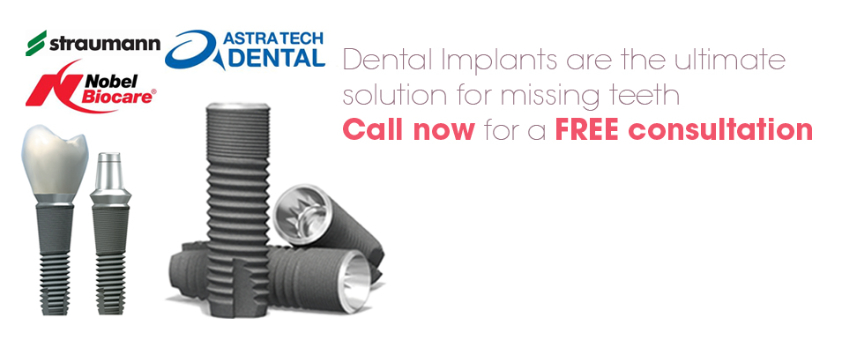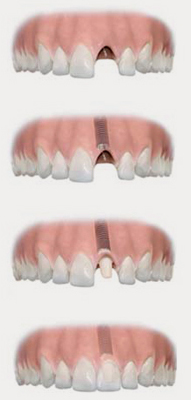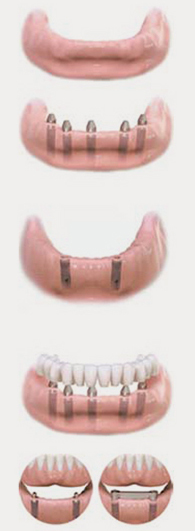Overview

A dental implant is essentially a substitute for a natural root, it is commonly screw or cylinder shaped. At our Surrey Implant Centre, each dental implant is placed into a socket carefully drilled at the precise location of the intended tooth. If an implant has a screw thread on its outer surface it can be screwed into position, otherwise it is usually tapped into place.
At Surrey Dental Implant Centre our main aim during installation of any dental implant is to achieve immediate close contact with the surrounding bone. This creates an initial stability, which is steadily enhanced over time by bone growth.
To support replacement teeth, Surbiton dental implants normally have some form of internal screw thread or post space that allows a variety of components to be fitted. Once fitted, these components provide the foundation for long-term support of crowns, bridges or dentures.
Dental implants are fitted at our dental clinic by our experienced implant specialists. Missing teeth often lose some of the surrounding soft tissue and bone. If there is significant loss, soft tissue and/or bone grafting may be required. Grafting occurs either before or during dental implant placement. Grafting procedures are carried out in-house at our Surbiton Dental Implant Centre.
We offer one of the best dental implant systems globally available. All implants are covered by a 10-year worldwide warranty.
We at Surbiton implant centre use internationally recognised and established dental implant systems.
What Is An Implant
In this video we show you what a dental implant is and how it works
When One Tooth Is Missing
This video shows consequences of non-treatment when one tooth is missing
Treatment
The different treatment methods available when one tooth is missing
Single Dental Implant
Tooth implants are considered the optimal dental replacement solution, especially when single teeth need to be replaced. A dental implant replaces both the lost natural tooth and its root.
Advantages Of Dental Implants Over Bridge Option:
Traditionally, a fixed bridge was considered the best dental replacement option for single teeth. In this type of restoration three false teeth were attached, with the middle tooth bridging the gap. While successful there were still many limitations compared to single dental implants.
Reduced Bone Loss:
If you lose a tooth, the bone around the area will slowly deteriorate, this can affect the shape of your jaw. Dental implants substitute the root of your natural tooth; helping the bone grow and preventing loss of bone structure.
Improved Function:
Dental implants restore the chewing function and allow you to eat food comfortably.
Neighbouring Teeth Stay Intact:
Bridge dental implant replacements require the grinding of healthy teeth to support the cemented bridge. With dental implants, the healthy adjacent tooth does not need to be ground down. The dental implant is an element independent from the rest of the teeth.
Improved Dental Hygiene:
With a fixed bridge cleaning is not as easy since three teeth are connected together. Special cleaning gadgets are needed for maintaining gums and teeth. However, a dental implant, like your natural teeth, just needs regular brushing, flossing and dental hygiene visits.
Improved Appearance:
Dental implants look just like your natural teeth. Gums can recede around a bridge exposing the metal base of the crown, whereas dental implants have better cosmetic results.
 Single Dental Implant Procedure:
Single Dental Implant Procedure:
Step 1:
The need to replace a missing tooth could be the result of an accident or because there was no predisposition for the tooth at birth.
Step 2:
The dentist makes a small incision to access the jawbone. The dentist will then drill a small hole and insert the screw-like implant. The incision is closed, and 3 – 6 months is given for the bone and implant to bond together. This process is called “osseointegration”. During this period, your dentist will prepare temporary tooth replacements which are purely cosmetic.
Step 3:
After the healing period, the gum is lifted and the abutment (a metal post) is attached to the dental implant. A temporary crown is placed on top of the implant.
Step 4:
Four to six weeks later, when the gum has healed, a final crown is placed on the abutment, fitting perfectly to the edges of the gum. The new tooth is now complete, it is virtually impossible to see the difference between the existing teeth and the new tooth.
Multiple Dental Implants
If you are missing several teeth your speech and chewing function can be can be affected. Implants provide stability and stimulates the surrounding bones to prevent loss. Attachable crowns are then fabricated and connected to the implants with a centre crown that sits over the gum. The bridge is long lasting, regardless of the condition of your existing teeth.
Advantages Of Implant-Supported Bridges Over Fixed Bridges Or Removable Partial Dentures:
Reduced Bone Loss:
Implant-supported bridges will replace some of your tooth roots to save the jawbone. With a fixed bridge or removable partial denture, bone slowly starts to disappear, over time it may have an impact on the shape and form of the jaw. Dental implants bond with your jawbone, keeping the bone healthy and intact.
Improved Function:
Dental implants become part of you as they integrate completely with your jawbone, restoring chewing and biting function. The results are increased comfort and confidence when eating and speaking.
No Need For Support From Neighbouring Teeth:
Implant-supported bridges replace teeth without support from adjacent natural teeth. Fixed bridges or removable partial dentures are dependent on support from adjacent teeth.
Improved Dental Hygiene:
Dental implants, like your natural teeth, need regular brushing, flossing and dental hygiene visits. The cement holding bridges in place can wear off, allowing bacteria to penetrate and cause decay.
Improved Appearance:
Dental implants are indistinguishable from your natural teeth – it will be difficult for anyone to tell that any dental work has been done. With a fixed bridge or removable partial denture, when the gum has receded after some time, you would be able to see the metal margin of the crown.
The Consequences Of Non-Treatment When Several Teeth Are Missing
This video shows the consequences of non-treatment when several teeth are missing
The Different Treatment Methods Available When Several Teeth Are Missing
This video shows the different treatment methods available when several teeth are missing
 Multiple Dental Implant Procedure:
Multiple Dental Implant Procedure:
Step 1:
Some people loose teeth in the back of their mouths. This is typically caused by gum infection or teeth cracking due to previous fillings.
Step 2:
The dentist makes a small incision to access the jawbone. The dentist then drills a small hole and inserts the screw-like implants. The incision is closed and 3 – 6 months is given for the bone and implants to bond together. This process is called “osseointegration”. During this period the dentist will fashion temporary tooth replacements which are purely cosmetic.
Step 3:
Abutments are attached to the dental implants. Next, a bridge is fitted; the new set of teeth is placed on the abutments. After the healing period, the gum is lifted and the abutments are attached to the dental implant. A temporary bridge is placed on top.
Step 4:
The dental implant bridge is now in place and can withstand the strong chewing forces that occur at the back of the mouth. It feels and functions like natural teeth.
Implant Supported Dentures
If you’re missing all of your teeth in the upper or lower jaw, a permanently anchored dental implant bridge or a removable prosthesis (connected to two or more dental implants) is the right solution for you. This is called an overdenture. This type of denture remains securely in place, more so than a conventional removable prosthesis.
Advantages Of Implant-Supported Full Bridges And Implant-Supported Dentures Over Conventional Dentures:
Reduced Bone Loss:
Implant-supported dentures and full bridges will replace some of your tooth roots, therefore saving the jawbone. Dental implants bond with your jawbone, keeping the bone healthy and intact. With conventional dentures, bone slowly starts to disappear, over time it may impact the shape and form of the jaw. Over years, the denture may need remodelling so that it fits the changing shape of the jaw.
Improved Function:
Dental implants become part of you as they integrate completely with your jawbone, restoring chewing and biting function. The result is increased comfort and confidence when eating and speaking. Bone loss causes the denture to move and slip, making it increasingly difficult to stabilise. Irritation and inflammation are common among denture patients. The remaining bone may not be enough to protect the jaw nerves from the pressure of biting and chewing. This type of pressure may cause extreme pain and discomfort.
Improved Dental Hygiene:
Dental implants, like your natural teeth, need regular brushing, flossing and dental hygiene visits. The cement holding bridges in place can wear off, allowing bacteria to penetrate and cause decay.
No Need For Drilling And Damaging Healthy Teeth:
Implant-supported bridges replace teeth lacking support from adjacent natural teeth. Fixed bridges or removable partial dentures are dependent on support from adjacent teeth.
Improved Appearance:
In the long term, implants can be more aesthetically pleasing and easier to maintain than conventional dentures. The loss of bone that accompanies conventional dentures leads to recession of the jawbone and a collapsed, unattractive smile.
The Consequences Of Non-Treatment When Several Teeth Are Missing
This video shows the consequences of non-treatment when several teeth are missing
The Different Treatment Methods Available When Several Teeth Are Missing
This video shows the different treatment methods available when several teeth are missing
 Implant Supported Denture Procedure:
Implant Supported Denture Procedure:
Step 1:
The dentist makes a small incision to access the jawbone. The dentist then drills a small hole and inserts the screw-like implants. The incision is closed, 3 – 6 months is given for the bone and implants to bond together. This process is called “osseointegration”. During this period, your dentist will prepare temporary tooth replacements for cosmetic purposes.
Step 2:
For a permanently anchored dental implant bridge, several implants are installed to form a good foundation. Since the dental implants are anchored in the jawbone they stimulate the bone tissue, maintaining healthy bone levels and facial structures. An overdenture involves installing two or more dental implants used as a secure foundation to attach the prosthesis.
Step 3:
The abutments are attached to the dental implants and the bridge is fitted in place. All dental work is performed according to your prerequisites and wishes. For the overdenture, either ball abutments or a small bar between the abutments are/is used. The prosthesis is fitted with corresponding devices underneath.
Step 4:
The dental implant bridge, or the overdenture, is now in place. It looks and functions like normal teeth. You can now eat whatever you like and laugh without having to worry about the prosthesis falling out.
Sinus Augmentation
 The major element in implant success is the quantity and quality of the jawbone where the implant is to be placed.
The major element in implant success is the quantity and quality of the jawbone where the implant is to be placed.
The maxillary sinuses are located in the cheekbones below your eyes. Tooth loss below the sinus leads to bone loss, over time the sinus will expand into the area previously occupied by bone and teeth. This lack of bone makes implant placement problematic.
If a dental implant is placed into inadequate bone, it will shift because it requires stability to withstand the forces of biting and chewing.
Sinus augmentation can help correct this problem by raising the sinus floor and developing bone for the placement of dental implants.
Over time, the implant and substitute bone will heal, creating a strong bond and stable foundation for your replacement teeth.
Sinus Augmentation
This video explains what sinus augmentation is and how it is treated
Bone Grafting
 If a lost tooth is not immediately replaced, the surrounding bone may shrink. Severe bone loss can make it impossible to place a dental implant. To rebuild the bone we must first access the area beneath the gums.
If a lost tooth is not immediately replaced, the surrounding bone may shrink. Severe bone loss can make it impossible to place a dental implant. To rebuild the bone we must first access the area beneath the gums.
A small block of substitute bone is shaped to restore the ridge to its original form. This procedure is called bone grafting. The block is secured with titanium screws and the surrounding area is covered with additional bone product to help create a natural shape. A special membrane is then placed over the site to improve healing. When the bone has successfully matured the titanium screws are removed.
This type of bone grafting can restore areas of severe bone loss, making it possible to successfully place dental implants and enjoy the benefits of secure replacement teeth.
Bone Grafting Ridge Preservation
In this video we show you what a bone grafting is and how it works
Bone Grafting AutoGraft
This video shows how a bone grafting autoGraft works
Bone Grafting Allograft
This video we show you how bone grafting allograft works
Sky Fast & Fixed Implant (Teeth In One Day)
Some of our case studies
- Four extremely decayed front upper teeth
SKY fast and fixed is an immediate implant placement technique, where a dental implant is placed while the natural tooth is simultaneously extracted. With this technique the placement of a fixed restoration is done in the same day or within 48 hours of implant placement if sufficient primary stability is achieved.
SKY fast and fixed is the most advanced teeth-in-a-day procedure created by the engineers and specialists at brendent with input from experienced implantologists, dental technicians and prosthetic specialists.
SKY fast and fixed offers:
- Fewer implant procedures needed to bring back your smile or mouth function
- More affordable prices than typical dental implants
- Same day teeth via extraction and implantation or temporary restoration
- No need for extensive surgical procedures
- Able to fix full arch failing dentition cases or edentulous jaws with or without a denture
- No more complications and reduced chance of errors during the procedure
- With SKY fast and fixed you can easily regain your ability to enjoy your social life and eat food properly as soon as the procedure is finished.
Watch How The SKY Fast And Fixed System Works
Watch How SKY Fast And Fixed Works
SKY Fast And Fix Is Carried Out In The Following Stages:
Step 1:
A thorough examination; the height and width of the jaw bone is determined through an X-ray and an CT scan. This is to ensure that implant placement is possible and that there is good quality bone both in height and width. Potential risks are identified, the dentist makes sure that the implant can be placed in the right direction to facilitate an aesthetically pleasing outcome.
Step 2:
Any residual teeth which are not worth saving are extracted and all inflamed tissue is removed. A few implants are then fitted under local anaesthesia, the patient can have this procedure done under sedation if they wish.
To make use of the existing bone, it is often necessary to fit posterior implants at an angle. This removes the need for surgical intervention to reconstruct the bone.
Step 3:
A temporary bridge will be produced and fitted immediately over abutments, these are placed over implants to help them support each other. This avoids overloading during the healing phase.
Many patients leave the practice after only a few hours with a fixed, implant-supported, temporary bridge. They will return two weeks later to have sutures removed.
Step 4:
After 3-6 months, the temporary bridge/crowns are removed and an impression is taken for a dental technician to make permanent bridges which look as natural as your original teeth. The permanent restoration will be fitted two weeks later.
Note: The dental surgeon must make sure the right protocol is applied. Patients are selected with utmost care when it comes to the quality and quantity of the bone. A proper treatment plan is carried out and implants are placed with sufficient primary stability to achieve predictable cosmetic results.
 Out of hours emergency:
Out of hours emergency:
 148 Ewell Road, Surbiton, Surrey, KT6 6HE
148 Ewell Road, Surbiton, Surrey, KT6 6HE


 +44 20 8339 9333
+44 20 8339 9333


 Single Dental Implant Procedure:
Single Dental Implant Procedure: Multiple Dental Implant Procedure:
Multiple Dental Implant Procedure: Implant Supported Denture Procedure:
Implant Supported Denture Procedure: The major element in implant success is the quantity and quality of the jawbone where the implant is to be placed.
The major element in implant success is the quantity and quality of the jawbone where the implant is to be placed. If a lost tooth is not immediately replaced, the surrounding bone may shrink. Severe bone loss can make it impossible to place a dental implant. To rebuild the bone we must first access the area beneath the gums.
If a lost tooth is not immediately replaced, the surrounding bone may shrink. Severe bone loss can make it impossible to place a dental implant. To rebuild the bone we must first access the area beneath the gums.









